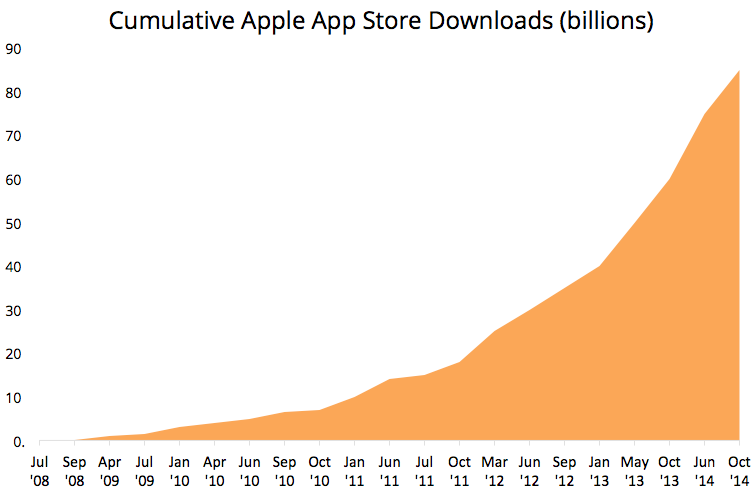We’ve all seen the ‘year of the mobile’ crop up in our news feeds for many years now. Thankfully these predictions are now in the past and mobile has been with us for some time. Responsive sites are becoming the norm and with Google labelling mobile friendly sites it suggests that aspects of mobile implementation are likely to influence the organic search algorithm in some way. But what about Apps?
You very rarely hear the SEO community discussing Mobile App Optimisation or App Store Optimisation (ASO), yet the volume of apps available and being downloaded grows at an incessant rate:

If Kim Kardashian can gross $222,904 daily from her Hollywood app there is definitely hope for the rest of us, we can definitely help our app audience grow.
Users need to wade through a lot to find the right app for them and below are some key areas we as SEOs can help influence a positive impact – especially considering 63% of people discover apps via a search (Nielson / Forrester).
Mobile App Optimisation Tips
Before we even think about the App Store itself we can start to influence the organic presence of the app by ensuring it is effective within your owned media channels.
1. Optimised landing page
We look at landing page optimisation all the time, but how many businesses out there have a mobile app and forget (or just plain don’t bother) about a unique page for promoting their own app? All the usual SEO best practices apply here, but try to ensure the page is feature rich and visually stunning to attract more app downloads and tell a story to create that emotional attachment from the outset.
2. Branded anchor text
When you are linking to your app download page, whether this is via the landing page above, or social channels try and utilise the brand name in the anchor text. Your app will likely have a branded title (if not see the ASO tips below!) so you want to reference this whenever possible.
3. Include app deep linking
Google have provided the ability to add deep links to your app for some time now. Essentially this allows you to deep link to in-app content from a mobile search, assuming the user has the relevant app installed, if they don’t they will be prompted to download the app.
4. Get reviews
A huge part of how your app will rank within the app store is how popular it is. You can help promote the app out with the app store by reaching out to relevant review sites. This will help get your name out there and hopefully garner some insight and trust and gather initial, essential downloads. Sites such as 148Apps.com can be great for exposure.
5. Promote, Promote, Promote
Again it sounds simple, but as marketers we must promote the app by submitting it to the main app stores. Link development and PR are a core for doing this and also tie in with getting positive reviews as per point 4.
App Store Optimisation
ASO is still in its infancy, a quote from Moz resonated well with me on the topic of ASO:
“We’re still in AltaVista mode in the app ecosystem”
We are used to the sophistication of Google search, but app store algorithms don’t have that level of complexity yet, they are a much simpler beast and so the tips might seem rudimentary but will certainly help with your efforts.
1. App title
One of the most important aspects of ASO, ensure it includes your brand first and foremost and some descriptive elements / keywords as to what the app does.
2. Description
Because of the content parsing on mobile devices, its back to thinking about what appears above the fold when the description is concerned. Ensure the first couple of sentences really hit home about the core principle of the app. Below the fold should be used to expand on the feature set, keep it simple and omit anything that’s superfluous.
3. Keywords
Gone are the days when we use the keywords meta tag in regular organic search, but as mentioned ASO harks back to an older era of search. Keywords should be highly relevant, have good search volume and no repetition. You only get around 100 characters here so you need to be as concise and targeted as possible.
4. Imagery
Icons and screenshots are hugely important for app store optimisation. We mentioned your app landing page being visually stunning, these elements also need to be similarly stunning. People are drawn to beautiful things. Make sure your app icon stands out and be sure your screenshots capture the essence of the app, with the core features in action so the user really feels like they know what they are getting.
5. Ratings
Ratings are a big ranking factor in ASO. Whilst it’s difficult to directly influence the ratings of your app, there are ways to influence this. Tools such as Apptentive allow you to power in app surveys and ratings, but you should also go down more traditional marketing routes, promote the app via social channels, blog about it and get it out there for people to see!
Building a presence for your mobile app is all about grass roots marketing, build the story of the app, making it visually appealing and factor in the basic optimisation techniques to ensure you have the foundations for success.


